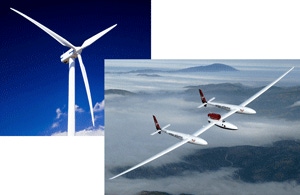Sandia Sizes up Wind Turbine Blade Design
January 25, 2011

By many accounts, wind energy, a relativeveteran among alternative energy sources, is well-positioned for a perfectstorm around growth: The politicalclimate is favorable, a downtrodden economy is hungry for economical andefficient fossil fuel alternatives and more than 30 years of research anddevelopment has been poured into wind energy innovations. Yet one of theremaining barriers to widespread adoption of wind energy is honing that rightmix of functionality for a wind turbine blade design that is large enough tosupport higher performance while retaining a form factor that is economical,reliable and can be produced on a grander scale.
SandiaNational Labs, and in particular, the Wind Energy TechnologiesDept., finds itself at the epicenter of that design challenge. The grouppartners with universities and industry to conduct applied research in the areaof wind turbines and blades to increase the viability of wind technology. Researchersat the lab are working on advancing knowledge around the areas of materials,structural dynamics, active-flow aerodynamic control and sensors along withpursuing innovations in the manufacturing processes and embeddedcontrols associated with wind blade design.
Sandia Sizes up Wind Turbine Blade Design_A |
"We're about developing innovationthat's five years, maybe 10 years out," says Tom Ashwill, P.E., distinguishedmember of technical staff at Sandia National Labs' Wind Energy TechnologiesDept. "The industry is risk-adverse to innovation - they can only look two tothree years out. We look to take risk off the table for them and try things wedon't know will work." The Sandia lab makes the results of its innovationefforts available to industry via reports, partnerships and through regular conferencesand workshops.
Large-Scale Blade Design
One of the department's primary areasof focus is innovation related to increasing the size of wind turbine blades.In the early 1980s, wind turbines averaged 100 kW, but the current averagecapacity is around 2 MW - a factor of 15 to 20 times more performance than whatexisted 25 years ago, Ashwill explains. As demand for performance increases, sodoes blade size, since blade length has a direct correlation to the increasedpower generating capacity of a turbine. As far as economics go, the thinking isthat fewer, higher-capacity wind turbines are more efficient and cost-effectivethan creating the infrastructure to support many smaller turbines, Ashwillsays.
Click here to read the sidebar "Developing Composite Wind Blades That Will Stand the Test of Time"
Current utility-scale turbines are equipped with blades thatrange from 40m (130 ft) to 90m (300 ft) in diameter. Sandia has a researchproject underway to advance that capacity to a 100m blade, which in atraditional three-bladed turbine design, would encompass a footprint in theorder of two-and-a-half football fields insize. This massive blade design, aimed at turbines that would reside 15 milesoffshore, creates significant design challenges around weight, structuralintegrity and manufacturability.
"As they get larger, the weight ofthese blades becomes an issue," says Craig Collier, president of Collier ResearchCorp., the maker of software used tooptimize composite materials and structural sizing that came out of work done at NASA LangleyResearch Center and now employed aspart of Sandia's research. "As they get larger, the question is: Can theywithstand their own weight without breaking? It's a big issue for the design ofnew blades." In addition to structural strength, design engineering issuesassociated with the larger blades encompass things like fatigue performance,buckling stability, blade stiffness, twist limits and wing-tip deflection.
HyperSizer's legacy in aerospace has helped entities likeNASA and companies like Lockheed Martin, Boeing and Bombardier, trim at least20 percent off the weight from wing structures. The software works without-of-the-box FEA solvers in a feedback loop to identify solutions thatminimize weight while maximizing structural integrity and manufacturability,Collier says. The software analyzes complex composite structures by evaluatingdesigns in a ply-by-ply and finite element-by-element manner, helping engineersoptimize all possible variations on a composite laminate design.
While FEA will give engineers insight into internal unitloads - for instance, how much air load goes into the skin of a blade or intothe spar cap - it does not, for example, provide analysis on overstressedmaterials or if a bonded joint is going to have a failure. That's where HyperSizercomes in, Collier explains. "HyperSizer will not only identify the problem, butwill go a step beyond and tell you whatto do to fix the problem," he says. "It has built-in intelligence to make thoserecommendations."
Leveraging HyperSizer's built-inoptimization and intelligence capabilities, Sandia plans to refine its baselinedesign for a 100m blade and optimize parts of the design to reduce weight. The software will be key in exploring how andwhen to add material variants such as carbon fiber, how to address active orpassive load controls, and for experimenting with different air foils as partof the ongoing research effort. Ashwill says he expects industry to releasewind turbines based on this blade research about seven to eight years in thefuture.
"We're just looking to apply innovation to larger bladedesign as we have in the past for smaller blades," Ashwill says. "HyperSizer will show us how to optimizethose designs."
About the Author(s)
You May Also Like





.jpg?width=300&auto=webp&quality=80&disable=upscale)

